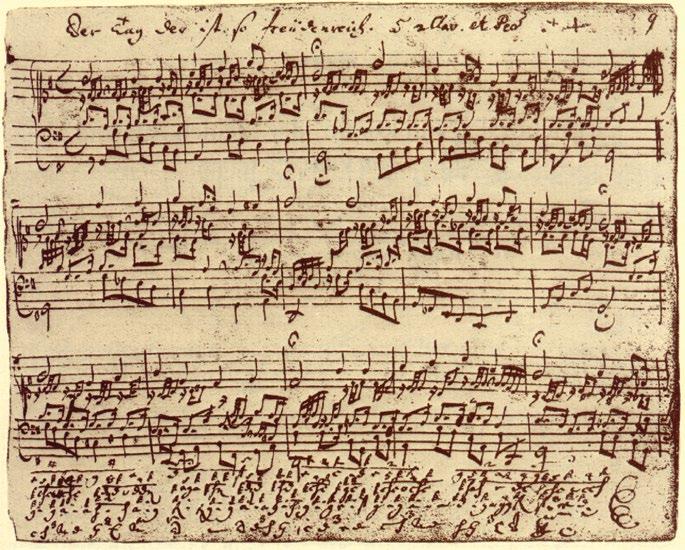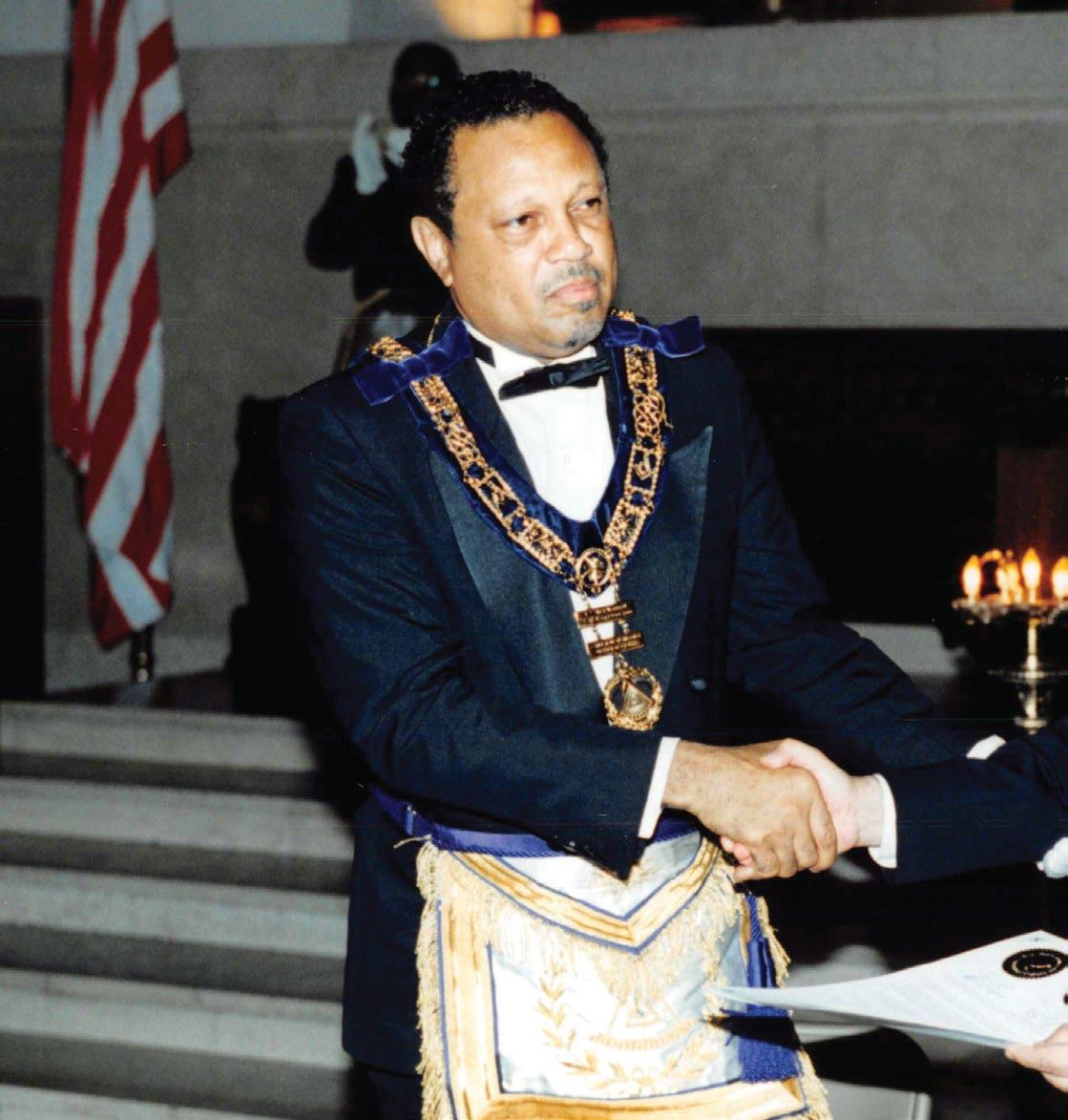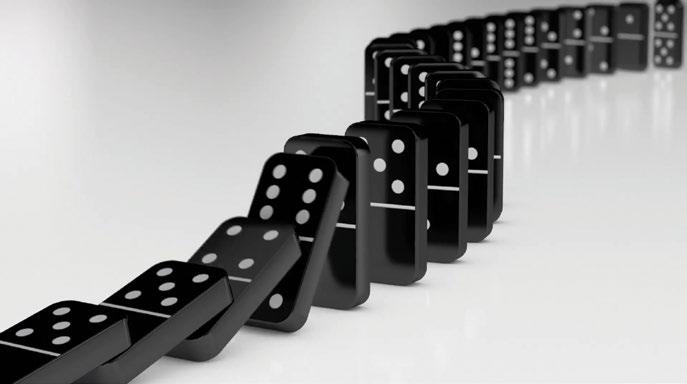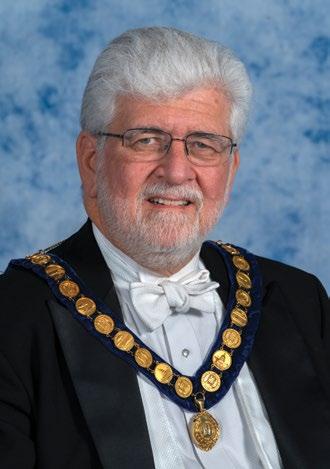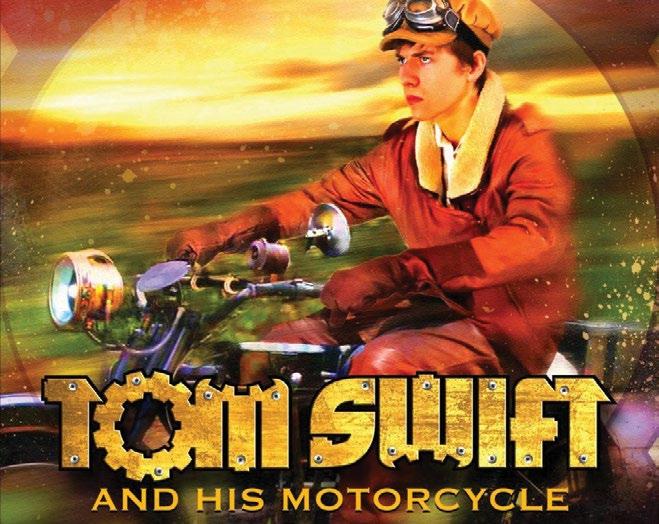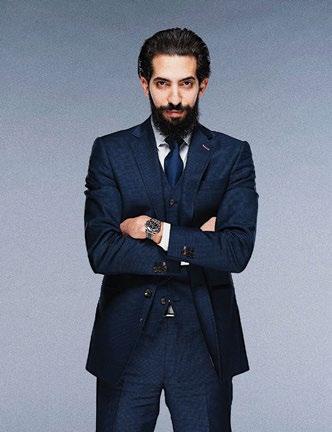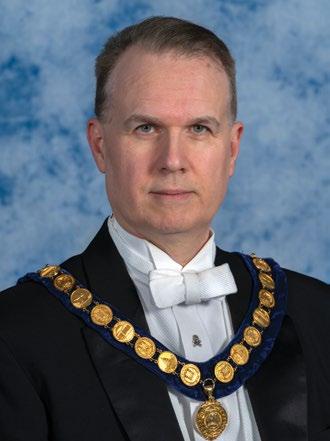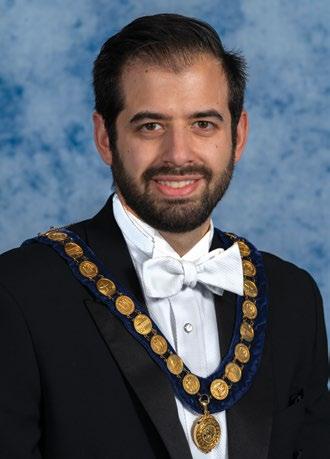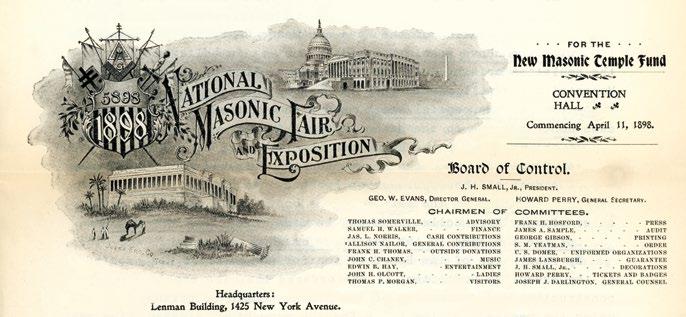
18 minute read
Mutual recognition in D.C. 20 years and counting: One Freemason’s observations
contact with Freemasonry and he helped bring countless men into the Fraternity. Occasionally, callers were interested in Prince Hall, and he would provide those callers with the appropriate contact information for MWPHGLDC.
WB Duerhing grew up in Waukesha, Wisconsin where, by his account, he learned that “separate is not equal.” And after several years of answering calls from men interested in the two separate Masonic bodies, WB Duerhing wondered whether a joint program might be warranted. He believed that it was important to strengthen the relationship between the two grand lodges. So, with the permission of the Grand Master at that time, MWB George Adams, WB Duerhing invited MWB Nathaniel M. Adams, Jr., the Grand Master of MWPHGLDC, to a festive board to be hosted by Hiram-Takoma.1
Advertisement
Records of the March 25 festive baord are sparse. Any pictures taken that evening have unfortunately been lost. However, we do know that the Junior Warden, Michael Dixon (now Michael Samet), served as chairman of the event. As recorded in the March 11 minutes, the meal was promised to be “homemade [p]asta.” and the Lodge introduced and sold its new toasting glasses. A subsequent publication reflects that “a capacity crowd filled the dining room for what was a historic day.” What brought that crowd—perhaps as many MWB Nathanial Adams in 2017 as fifty men—to the upstairs room was the guest speaker: MWB Nathaniel Adams, accompanied by “several of his officers and a Past Grand Master.”2 After recounting the history of Prince Hall, MWB Nathaniel Adams described some of the organization’s work in D.C., including its “…blood bank program, high school scholarships and [its] hopes to award $50,000 to deserving high school seniors.”
MWB George Adams, however, didn’t hear that speech, because did not attend the table lodge. According to WB Duerhing, that was because he “…felt it more important for the Lodge to make the connection than to make it about the two Grand Lodges.” He also wanted to avoid overshadowing MWB Nathaniel Adams and the extension of Hiram-Takoma’s fraternal hand to MWPHGLDC.
What is perhaps most remarkable about this festive board is how otherwise unremarkable it was. One would expect that such an august and important event would be worthy of far more attention than it received in 1993. But the relative lack of attention it received tells us of its total ordinariness. That those who attended saw no reason to record or memorialize the greatness of the evening’s events is evidence that they saw nothing out of the ordinary about breaking bread across racial lines.
In the words of WB Neal Jarvis, who served as Hiram-Takoma’s Senior Steward in 1993, “The generation we were raised in did not see differences in others, except on issues of personality—not race or religion.” Perhaps those men—who crowded the Takoma Masonic Center’s dining room on that historic day—understood
1 2 It was providential that the two Grand Masters’ surnames in 1993 were “Adams.” They would become close friends and acquire the endearing designation, “The Brothers Adams.” As many as ten, as recalled by one Past Master present that evening
Tile at Takoma Masonic Center

The Festive Board was held in the refrectory of the Takoma Masonic Center.jpg

the interrelationship between black and white better than their non-Masonic contemporaries.
The unity initiated on March 25 has grown and flourished since 1993. Later that year, the two Grand Lodges joined together to reenact the cornerstone laying at the United States Capitol. And the continuing vitality of the relationship is evidenced most recently in the joint statement issued by MWB Michael D. Nicholas, Sr. (Grand Master of DCGL) and MWB Quincy G. Gant (Grand Master of MWPHGLDC) in response to the protests and unrest following the murder of George Floyd.
“We are united as a Sacred Brotherhood,” they write. Continuing, “…we have since outgrown those divisions and forged between us the ties of Brotherhood that unite us as Freemasons. Freemasonry is strong and vibrant in Washington DC, and we have a role to play in the healing that our city requires.”3 But to fully understand that unity, it is important to remember how it was borne. Like the checkered marble floor, the March 25 festive board is integral to the foundation of brotherly love and affection upon which our Fraternity in D.C. today rests.
I am grateful to Neal Jarvis and Todd Duerhing for sharing their memories of the March 25 dinner, as well as to our Grand Historian, Chris Ruli for his research assistance. Thanks also to Hiram-Takoma’s Junior Deacon, Christopher Burkett, for inspiring my interest in the union between the two Grand Lodges.
Joint Statement of Washington, D.C. Grand Masters (June 2, 2020), https://imgur.com/SIjPRtd.
A MOMENT IN HISTORY: REMEMBERING MUTUAL RECOGNITION WITH PRINCE HALL
By Chetin Durak Senior Grand Steward
On September 11, 2000, Brethren, guests, and media gathered at the House of the Temple to celebrate over 200 years of American history in the nation’s capital. Federal Lodge No. 1 directed the festive occasion, holding what was for them a Special Communication with a performance by the U.S. Army Chorus, and a presentation given by the Architect of the Capitol. National treasures used by Illustrious Brother George Washington Chetin Durak were prominently displayed. Potomac Lodge No. 5 showcased the George Washington Gavel from the cornerstone laying of the US Capitol, while Fredericksburg Lodge No. 4 and Alexandria Washington Lodge No. 22 under the Grand Lodge of Virginia displayed the George Washington Bible and Trowel respectively.
Of all the invitations honored and presentations offered, the highlight of the evening was a “surprise” historic achievement that manifested the values of our craft. It was on this day that the Grand Master of the Grand Lodge of Washington, DC (District of Columbia), MWB Mansour Hatefi, and the Grand Master of the Most Worshipful Prince Hall Grand Lodge of the District of Columbia, MWB Willie Griffin, came together in an act of unity
MWB Willie H. Griffin


MWB Mansour Hatefi
and brotherhood to sign the proclamation providing for mutual recognition between our Grand Lodges.
As we commemorate the 20th anniversary of this historic occasion, we pause to reflect on the vision of our inspirational Brethren and the Masonic principles that guided their enlightenment. Over a decade of due attention to Masonic teachings, dedication to living the ideals of the Craft, and steadfast leadership resulted in the overdue mutual recognition between our Grand Lodges.
In the late 1980s, two elected Grand Lodge officers, RWB Jerold Samet and RWB George Adams, found themselves circling the beltway, enthralled in conversation around each other’s lives from
The U.S. Army Chorus performs at the signing

MWB Hatefi speaks from the podium with Federal Lodge No. 1 Master, WB Alfred C. Boswell, Jr. behind

Brethren on the sidelines that day

MWB George Adams knees at the altar, flanked by MWBs Griffin and Hatefi

youth to adulthood. Both Brothers, who would later become Grand Masters, seized the opportunity to develop 21 goals grounded in core Masonic principles that they aspired to accomplish before leaving the Grand East. As MWB Adams shared, their “goal wasn’t to change the world, but was to carry out the ideals of our society of Freemasons.” Among these was the mutual recognition between our Grand Lodge and Prince Hall’s. They understood that this could not be achieved without the exercise of Brotherly Love and Truth combined with the Masonic exemplification of universality within our own Grand Lodge.
They immediately went to work to ensure that Brotherly Love transcended race, creed, color, ethnicity, national origin, religion, and lifestyle within our jurisdiction. As MWB Samet explained, “In order to make it a true brotherhood, we needed to make it a brotherhood for everyone, a universal brotherhood.” Our esteemed Brethren understood the importance of laboring to ensure the ground was level before laying the “foundation stone of a new beginning between these two Grand Lodges,” as MWB Adams so eloquently recalled.
Through the combined efforts of MWB Stewart Miner, MWB Jerold Samet, MWB George Adams, and WB Victor Adegbite, the color and ethnicity barriers of the past were shattered piece by piece. Our esteemed Brethren began forging the path of universal freemasonry with the introduction in 1990 of the first bilingual Lodge since Arminius Lodge No. 25’s chartering in 1876, Mehr Lode No. 90. Mehr Lodge provided an environment where Iranian-American brethren could practice the Craft in their mother tongue, Farsi, and in the emulation ritual. The efforts of MWB Charles Iversen, MWB Robert Heyat, MWB Dan Frederick, and MWB Mansour Hatefi spurred diversity in our jurisdiction that had previously been unimaginable.
MWB Iversen praised MWB Hatefi saying, “He guided its affairs so successfully that other Masons approached the ensuing Grand Masters for dispensations to form more bilingual and English-speaking lodges.” Indeed, he observed that, “Our nation’s capital is the logical place for this concept to bear fruit, being the center of international activity in our country.” These efforts not only facilitated forming fraternal bonds between Brethren of different backgrounds within the jurisdiction, but also naturally strengthened ties with brethren around the world.
With the Masonic mosaic continuing to evolve along the ideals of the fraternity through the late 1980s and 1990s, the hour had arrived to recognize the fraternal bond between our Grand Lodge and Prince Hall’s. Despite pockets of resistance on both fronts, ranging from matters of differing ritual and membership retention to the unfortunate and unmasonic issue of racism, those voices were the minority by the time the Grand Lodges brought the matter to a vote. Tellingly, it was the long and measured path of progress towards broadening our consciousness, and thereby our universality, that allowed our Grand Lodges to confidently introduce this measure for a vote.
Our leadership was fortunate to work with such esteemed Prince Hall Brethren as MWB Nathaniel Adams and WB Jeffrey Ballou to
exemplify the mystic tie that binds us all into one band of brothers. These luminaries of our Craft had the patience and perseverance to give this matter their due attention and to use the working tools of our noble art to speak with brethren across the jurisdictions to alleviate their concerns. By living the principles of Brotherly Love and Truth, and exemplifying universality, the arguments of the resisting brothers were naturally disarmed.
By the time the issue came to the floor of the Grand Lodge, its way was softened with representation of a more diverse body of men in all respects, practicing various rituals in myriad languages. Hence, mutual recognition was accomplished with our Grand Lodge under the leadership of MWB Dan Frederick, who led the Grand Lodge when it passed on May 17, 1999, and in Prince Hall’s under MWB Willie Griffin on December 9, 1999. The ensuing proclamation in 2000 was accompanied by “Suggested Guidelines for Visits Between Brethren” of the two Grand Lodges as a first step to facilitating visitation. These guidelines were readily removed in 2005, when MWB Leonard Proden and Prince Hall’s MWB Robert Wheeler signed a compact to further strengthen the fraternal bonds between our jurisdictions.
As we celebrate the twentieth anniversary of this welcome symbol of unification in the Grand Lodges of our nation’s capital, we recall MWB Hatefi’s uplifting and celebratory words from the start of the new millennium in 2000: “This is the time to look back with By Jeffrey P. Ballou, PM Social Lodge No. 1, MWPHGLDC and Honorary Member, Potomac Lodge No. 5 Master and curent Grand Secretary Jeff Russell. He presented me with an interesting proposition to reflect on the mutual recognition journey so far since my home jurisdiction is the Most Worshipful Prince Hall Grand Lodge of D.C., F&AM, Prince Hall Affiliation, and I am an honorary member of Potomac Lodge No. 5 of the Grand Lodge of the D.C., WB Jeff Ballou photo courtesy Tony Powell Images F.A.A.M. But before I begin, please note: these are personal recollections and do not represent the official views of either jurisdiction that I owe allegiance, affiliate with, or mention. AN IDEA HATCHED ON THE BACK OF A NAPKIN It’s hard to believe that 2020 marks twenty years since the Most Worshipful Prince Hall Grand Lodge of D.C. Free and Accepted pride and to look forward with confidence…We are giving reality to the Masonic ideal of universality.”
At the signing of the proclamation, “Past Grand Master Adams then knelt at the altar between the two Grand Masters who placed their respective hands on either of his shoulders while he asked the Grand Architect of the Universe to bless the union of these two Grand Lodges,” wrote MWB Hatefi. MWB Adams noted that he could feel the energy of unity at that moment.
That energy continues through today and has empowered our Grand Lodges to show a united front in the face of intolerance, in support of our community, and in the practice of Freemasonry. As WB Jeffrey Ballou wrote to the brethren of our Grand Lodge following the ceremony of mutual recognition, “Once again we have the opportunity to show the world who we are and what we can do.” This opportunity that WB Ballou so astutely referenced is ever present. It is paramount that we as Brethren continue to reflect and act on our history and principles that we may continue to build the edifice so held together by the cement of Brotherly Love.
*Special thanks to MWB Jerold Samet, MWB George Adams, and MWB Mansour Hatefi for taking the time to share our Grand Lodge’s
ONE PRINCE HALL MASON’S VIEW
Itook a call recently from my good friend and brother Past Grand
history with me in support of this article. Masons, Prince Hall Affiliation and the Grand Lodge of D.C. Free and Accepted Masons signed a mutual recognition accord at the House of the Temple.
It seems like just yesterday when there was a mix of excitement, relief, and trepidation right after the treaty signing. There was a lot of hope then that going forward, brothers from both jurisdictions would visit each other in earnest and perhaps share in degree work and inspire others to follow.
Past Grand Masters Dan Frederick, Nathaniel Adams, Jerold Samet, Willie Griffin, and George Adams, along with key officers and committee members who crafted and shepherded this historic treaty, the first in the U.S. South, had sought to foster better communication, visitation, and cooperation between the two jurisdictions to try and deal a fatal blow to racism in our fraternity. As Past Grand Masters George Adams, Jerold Samet and the late Dan Frederick had been fond of saying, it was an idea literally hatched on the back of a napkin.
The journey from legislative passage in 1999 to treaty signing in 2000 was not a perfect one, as written in the book Out of the Shadows: The Emergence of Prince Hall Freemasonry in America (Over 225 Years of Endurance), co-written by good friends and brothers Alton Roundtree from my jurisdiction and Past Grand Senior Warden Paul Bessel from the Grand Lodge of D.C. Page 255 zeroes in on how the mutual recognition treaty really came
together, or at least it talks about what can be told. In fact, there The strongest bonds however, have happened on more local level. were many tough moments that were not detailed in the book, Brothers have observed and and even been invited to participate which actually speak to how the agreement almost fell apart. in one another’s degree work. Genuine friendships have emerged of diplomatic bliss was BENEFITS OF BONDING To be fair, our cooperation has manifested itself more positively than not over the years, and far beyond words on paper can describe. The two jurisdictions exchange delegations at each other’s annual sessions and other official occasions. There have been joint service-related outings and participation in universal brotherhood celebrations. Initially only granted to the late Most Worshipful Past Grand Master Nathaniel Adams, a tweaking of the treaty was made to grant honorary membership to one another’s Grand Officers, and on occasion became something mutually offered. between Grand Masters. But the good news is that And a host of Lodges, it didn’t. It was signed, including my own Social and now I will make my Lodge No. 1 (who led own attempt, from just the way visiting), have one Freemason’s point socialized and engaged of view, to tell what has in civic service with happened since the big many lodges in the ceremony. Grand Lodge of D.C. such as Benjamin B. GROWING PAINS French Lodge No. 15, One of the first hurdles Lodge No. 1798, was to break the ice Federal Lodge No. 1 and on visitations. What Potomac Lodge No. 5 followed a initial season just to name a few. followed by the fine I’ve watched brothers print—well meaning, like Most Worshipful but cumbersome Brother Joe Crociata visitation rules. While and Past Master Chris no one wanted to Thigpen, or Worshipful be discourteous, the Brothers James Morgan consequence was and Jeff Holt respectively cause for rank and file befriend each other. I’ve frustration from brothers also seen the admiration in both jurisdictions just and humor present in trying to be friendly with the friendship between one another. Past Grand Masters What I have observed and his counterpart since has been a gradual George Adams, who growth in mutual affectionately referred to visitation which, one another as “cousins.’ depending on who was Or Past Grand Masters Grand Master, received Robert Wheeler and great periods of support Len Proden who showed and progress. Or, to be genuine affection for honest, on occasion, each other, as they rolled times of inaction and up their sleeves to do the even regression. MWBs George Adams and Nathaniel Adams at the recognition signing in 2000 craft’s work.

Sojourner Kilwinning Nathaniel Adams Some of the most memorable demonstrations of our shared brotherhood, however, emerged with powerful eulogies and deep presence for some of the key figures who helped shape and/or fight for our shared amity, such as Most Worshipful Past Grand Masters Nathaniel M. Adams, Jr. and Daniel Frederick when they laid down their working tools.
HIGHS AND CHALLENGES Over the course of 20 years I have had the privilege of a front row seat, witnessing and experiencing the good and the challenges of our growing
Dan L Frederick

Nathanial Adams


Jerry Samet

George R. Adams
relationship. Through recognition, many of us have gained a host of incredible friends and brothers from all over the world. I’ve seen the quarterly communication of the United Grand of England, participated in Freemasonry practiced in England, the U.S. Capitol, the Bahamas, witnessed multilingual and in the U.S., multi-state rituals, met brothers in Italy, and elsewhere. And together, we have watched diplomatic triumphs and stumbles.
An ongoing challenge over the last 20 years has been that as other groups sought amity, we ensured that both Grand Lodges kept recognition to regular Masonic bodies. There were no shortage of folks who wanted to get in on the well-earned fellowship our grand jurisdictions built, but who didn’t play by the rules of regular Freemasonry. Thanks fully to the lodge principal officers, Grand Secretaries, Grand representatives and chairmen of the committees of Foreign Correspondence, though, our West gate remains secure.
We have also watched as some on both sides who fought for recognition were ridiculed, officially sidelined, and even took political hits to various degrees, because they stood up for universal brotherhood. Thankfully, the good karma is that true amity remains redemptive to all, whether you believed early on, today, or may come around tomorrow.
Lastly, the major secret to the success of the treaty has been our families, loved ones, and friends. I’ve met many spouses and significant others of brothers in both Lodges. They are the support, reality check, and real diplomacy that courses through our agreement.
SOFT POWER Given our location, host to the seat of U.S. government and scores of embassies, our mutual cooperation became a two-fold Masonic bonding force. One area of fraternal accord was better socialization through domestic and international governments who might otherwise not be in the same room together. A second became a powerful springboard for mutual recognition advocates in other jurisdictions, research societies, allied, appendant, concordant, and special bodies. The most prominent example to date in D.C., being the joint travel and participation in the tricentennial celebrations of the United Grand Lodge of England.
Another soft power which continues to provide currency to our treaty and others, are Masonic research societies like Philalethes, Phyllis, Scottish Rite Research, The Masonic Society, and a host of other research lodges and Phylaxis. It’s their search for truth and bonds that drew me into the recognition discussion. Their zeal to do things based on scholarship provides ‘white papers,’ and other materials that ensure policy decisions proceed on a factual basis.
THE ROAD AHEAD The U.S. overwhelmingly supports mutual recognition with Prince Hall. However, there remains a long road to go before anyone can declare complete and total détente in all areas. We haven’t crossed every barrier to full recognition.
Widespread dual and plural voting membership is one of the last big hurdles. Beyond our borders in D.C., there also remains a handful of U.S. states who still have not recognized each other. This challenge, given the current racial reckoning afoot, perhaps will inspire brothers in those states to seize the moment and finally forge official recognition and visitation ties. More importantly, friendships to further the cause of brotherly love.

